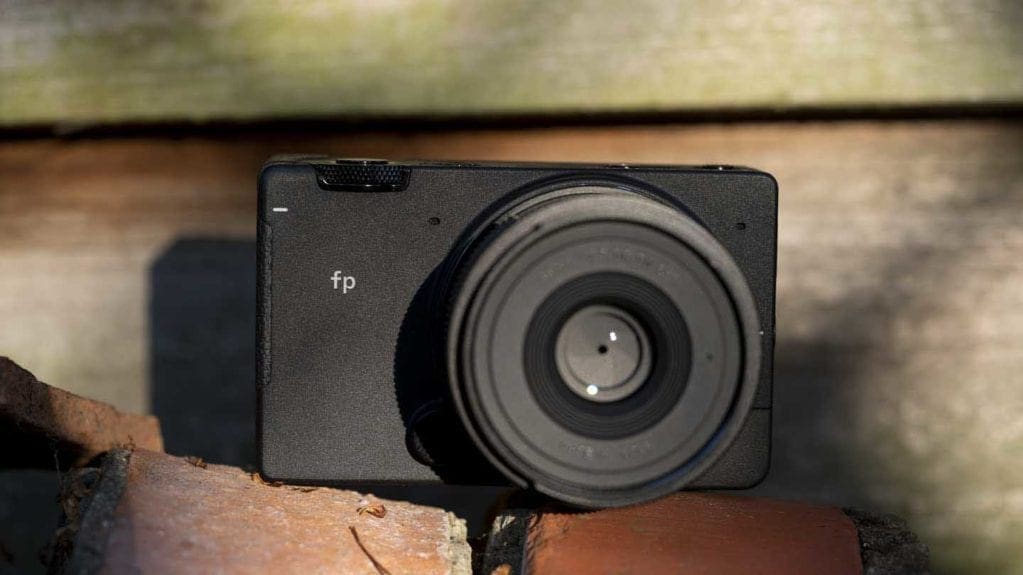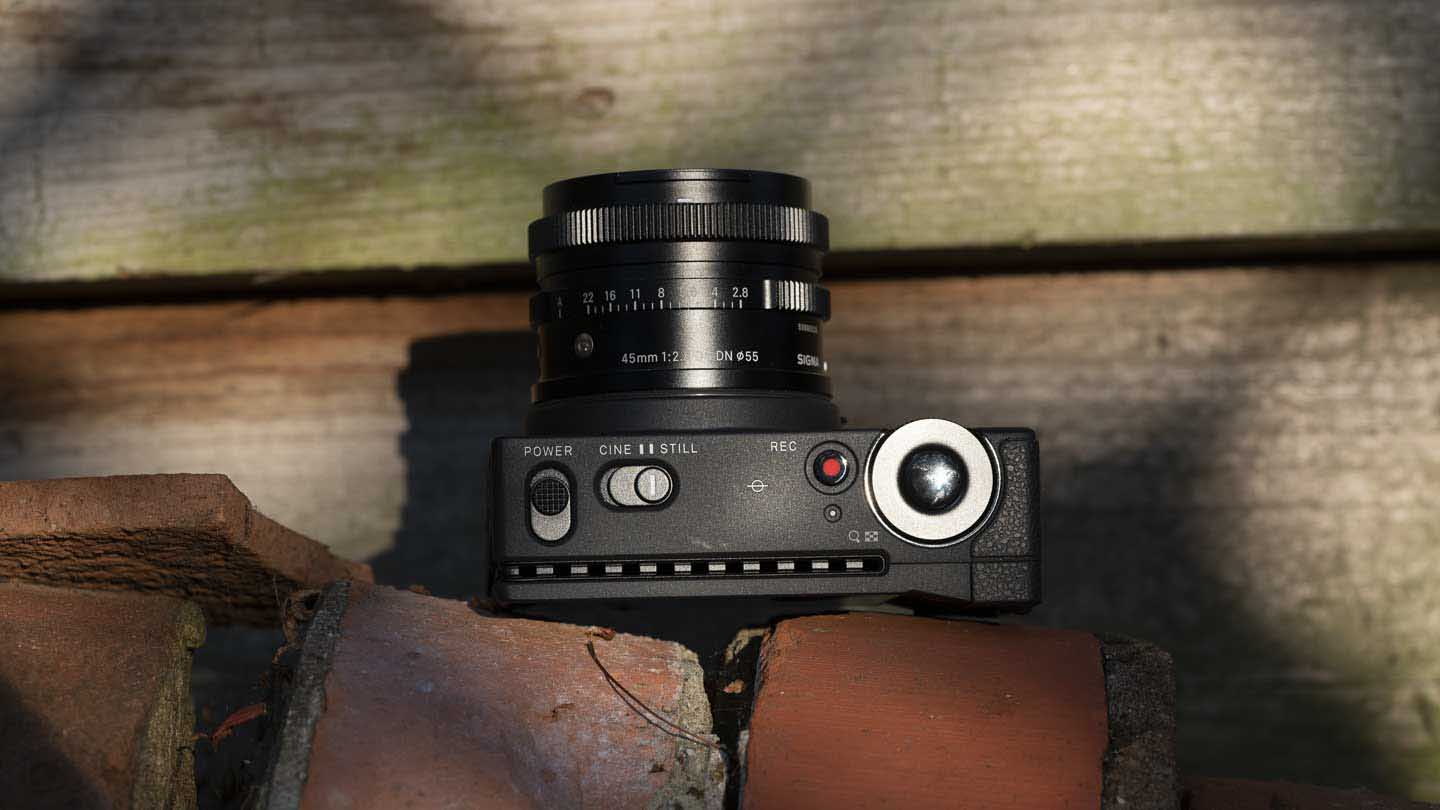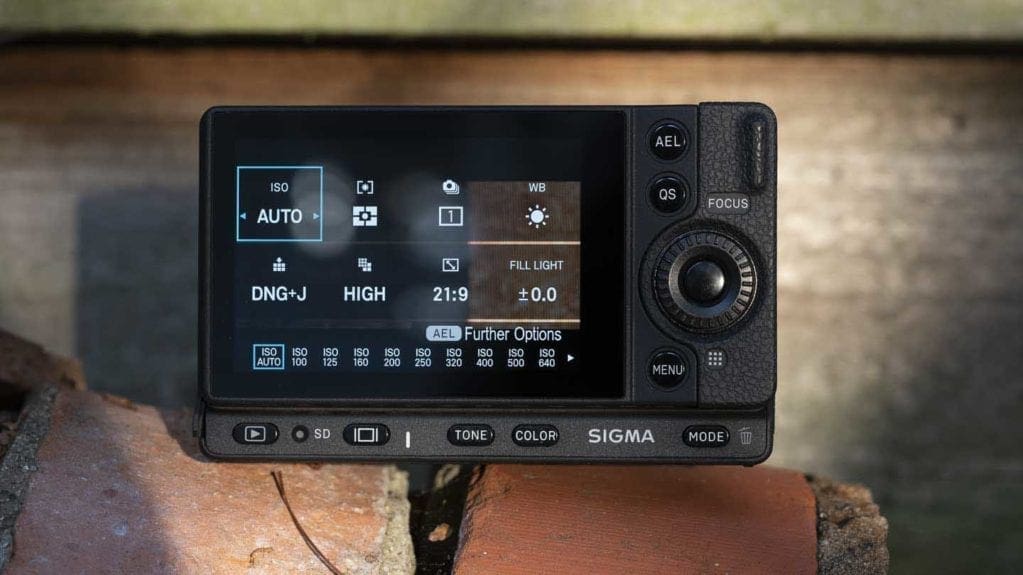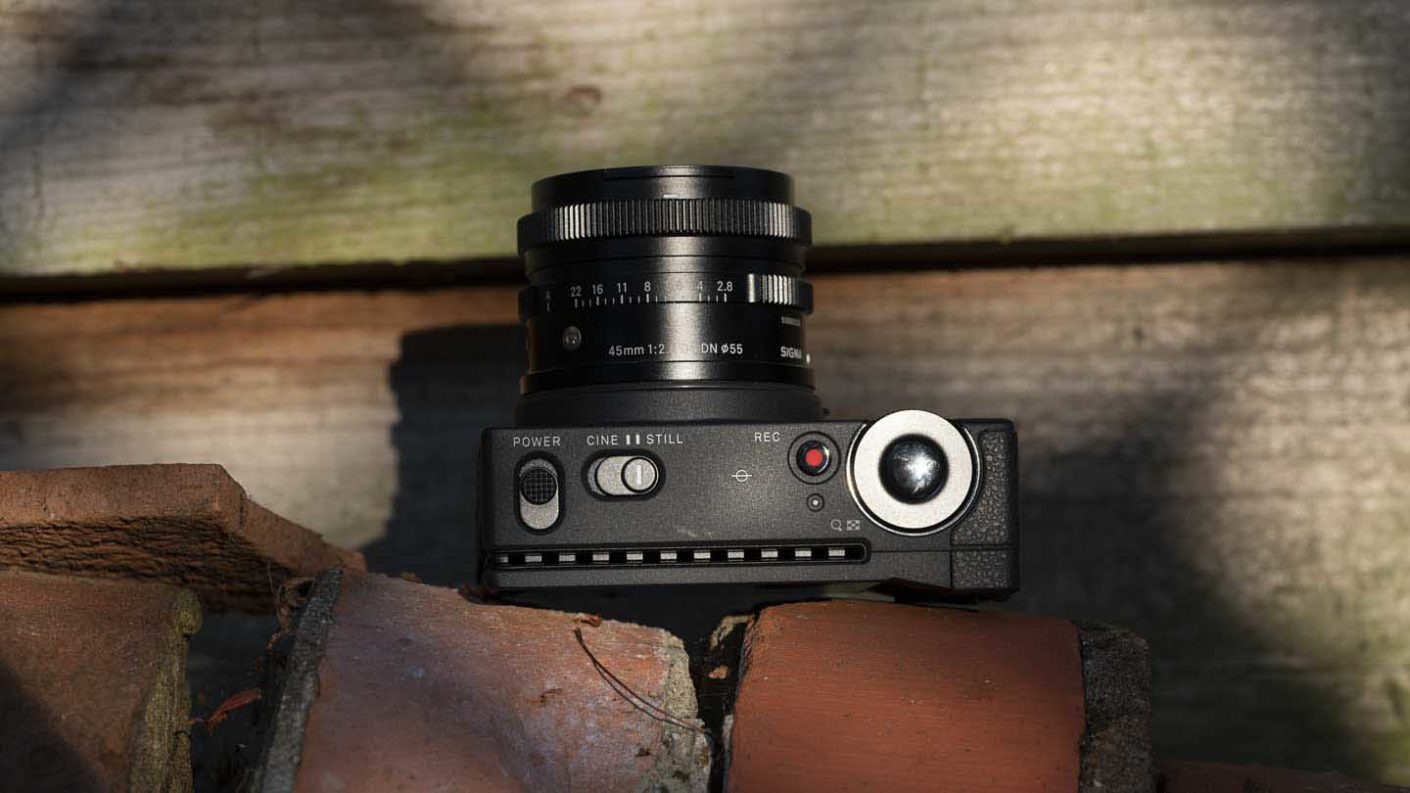As well as being the world’s smallest and lightest, full-frame mirrorless camera, the Sigma fp is Sigma’s first camera to feature the L mount which is also used by Panasonic and Leica. However, Sigma has always done things a bit differently when it comes to cameras and the fp is unlike any other camera around at the moment. That’s good and bad.
Our Verdict
Sigma deserves credit for producing something a little different but the end result is a camera that won’t suit the majority of people. The fp is a modular camera with some great features and an excellent interface that’s capable of producing high-quality results. However, the lack of a viewfinder and anything resembling a front grip without an accessory, plus the fixed screen limit its appeal.
For
- Small for a full-frame camera
- Excellent interface
- Rig-ready
Against
- Brick-like shape without accessory grip
- No viewfinder built in
- Fixed screen
What is the Sigma fp?
Specification
- Camera type: Mirrorless
- Sensor: 24.6Mp Full-frame (35.9×23.9mm back-illuminated Bayer CMOS
- Lens mount: L
- Screen: Fixed 3.15-inch 2,100,000-dot electrostatic capacitance system touch panel
- Viewfinder: No
- Sensitivity range: ISO 100-25,600 expansion settings of to ISO 6, 12, 25, 50, 51,200 and 102, 400
- Maximum continuous shooting rate: 18fps for 12 images
- Video resolution / frame rate: 3,840×2,160 (UHD 4K) / 23.98p, 25p, 29.97p, FHD (1,920×1,080) / 23.98p, 25p, 29.97p, 59.94p, 100p, 119.88p
- Video format: CinemaDNG(8bit / 10bit/ 12bit) / MOV:H.264 (ALL-I/ GOP)
- Autofocus system : Contrast detection with 49 points
- Image stabilisation: Electronic
- Shutter type: Electronic only with speeds 30-1/8000 sec and Bulb
- Storage: SD/SDHC/SDXC UHS-II or Portable SSD via USB 3.0 connection
- Dimensions: 112.6 x 69.9 x 45.3mm
- Weight: 370g body only, 422g with battery and SD card

Features
Sigma normally uses a Foveon sensor in its cameras but it has used a conventional chip with a Bayer pattern coloured filter array for the fp. It’s a back-illuminated sensor with 24.6million effective pixels on its 35.9×23.9mm surface and there’s no low-pass filter.
Interestingly, the native sensitivity range is ISO 100-25,600 but there expansion settings that take it down to as low as ISO 6 and as high as 102, 400. The lower settings are enabled by compositing a series of images shot at ISO 100, which means it’s strictly for motionless subjects.
In a change from the norm, the Sigma fp doesn’t have a mechanical shutter. Instead, it operates full-time with an electronic shutter. As well as being silent, that helps to keep the size down, but it means that images of moving subjects or that are shot when the camera is panning are prone to suffering from the effects of rolling shutter.
As there are no phase detection pixels on the fp’s sensor, it uses contrast detection for focusing with face and eye detection.
Video
As well as stills, the Sigma fp can shoot video. Enticingly, when an external SSD is connected it can shoot 4K (3840×2160) footage in CinemaDNG format with up to 12bit colour. Alternatively, when an SD card is used, the more common MOV format is available.
There’s also a collection of colour styles that can be applied to stills or video: Standard, Vivid, Neutral, Portrait, Landscape, Cinema, Teal & Orange, Sunset Red, Forest Green, Foveon Classic Blue, Foven Classic Yellow, Monochrome.
The low saturation Cinema and Teal & Orange settings are particularly interesting for videographers.

Build and Handling
The Sigma fp is remarkably brick-like in both build and shape. Its rectangular form feels very solid and its front and back are covered with die-cast aluminium alloy. It’s also sealed against dust and moisture at 42 points.
However, in the absence of an accessory grip, it’s an unnerving camera to hold. The front is completely flat and there’s just the slightest thumb grip on the back, so it doesn’t feel especially secure in your hand.
In another usual move, the strap lugs attach via 1/4-inch threads which means that they can be removed and the threads used to mount the camera on a tripod. The thread on the left side of the camera (as you hold it) is aligned with the centre point of the lens – just like the one on the camera’s base. That means you can flip between vertical and horizontal shooting on a tripod without changing the composition horizontally.
While its shape isn’t ergonomic, the Sigma fp is well-suited for use in a rig. There are no awkward protrusions and the three 1/4-inch threads are available for mounting a cage or other accessories.
If you’re shooting stills, one of the accessory grips is nigh-on essential.

Control Layout
Although its form factor raises questions, the control layout it of the fp is very good, giving you quick access to the most important features.
The compact 45mm f/2.8 kit lens has an aperture ring, with settings marked in 1/3Ev steps down to f/222. It’s a quick and intuitive way of controlling the aperture.
Meanwhile, there are dials on the back and top of the camera around the shutter release for adjusting the shutter speed and exposure compensation.
As usual, there are Menu and Quick Set menu (QS) buttons on the back of the fp. Lower down, beneath the screen, there’s a row of five buttons. Three of them are fairly standard, one to playback an image, another to change the view on the screen and the other to give access to the exposure mode options.

The two others marked Tone and Color are a bit more interesting. Pressing Tone activates a screen with a tone curve to adjust the contrast. As you might guess, pressing the Color button enables you to select the colour style that you want to use (Standard, Vivid, Neutral, Portrait, Landscape, Cinema, Teal & Orange, Sunset Red, Forest Green, FOV Classic Blue, FOV Classic Yellow, Monochrome).
While I always shoot raw files, I also always shoot Jpegs at the same time and I like to get the colours I want in-camera. The Tone and Color buttons make doing this a little bit easier. The direct route to them also makes you feel a bit more in control of things.
Stills or Video
One of Sigma’s aims for the fp is for it to work as well as a video camera as it does for stills and vice versa. A switch on the top-plate lets you swap quickly between the two modes. When you do so, the features displayed in the Quick Set (QS) menu changes to suit what you’re shooting. That’s something we’ve been asking for from other manufacturers, so hats off to Sigma!
The QS menus are also customisable so you can reach the features you use most often in video or stills mode.
Screen and Viewfinder
On the back of the Sigma fp there’s a 3.15-inch touchscreen with 2,100,000 dots. This provides a clear view that’s bright enough to be seen outdoors. It also gives an accurate preview of the final image’s colour and exposure.
However, the screen is fixed, which is frustratingly limiting. A tilting screen would make the fp more attractive for creative photography and videography.
Tapping the display button toggles you through the four display modes including one with no information on show and another with an electronic level.
Another disappointment is that the fp doesn’t have a viewfinder built-in. Not only that, there isn’t an optional one to attach. There is, however, a large loupe, the LVF11 LCD Viewfinder that fits over the screen to turn it into a kind of viewfinder. It’s a bulky solution though.
I’d also like Sigma to make greater use of the screen’s touch-sensitivity. It would be nice to be able to tap on the screen to select main and Quick Set menu options for example.

Performance
While the Sigma fp’s design may be unconventional, its image quality is what we expect from a 24Mp full-frame camera.
Exposure is handled reasonably well in a range of conditions, but the exposure compensation control gets quite a bit of use. However, as the screen gives a good preview of the image, that’s not much of an issue.
I recommend underexposing a little as the highlights burn out quite quickly.
The colours look a little flat from the Standard mode, but that’s preferable to excessive saturation, and Vivid is on hand if you need a bit more oomph.
Generally, in the default settings, the micro-contrast of the Jpegs is on the high side. I much prefer the raw files.
Autofocus
While it’s not the fastest system around, the Sigma fp’s autofocusing is pretty good with stationary subjects at a reasonable distance. If the subject gets close to the 45mm lens’ minimum focus distance it struggles quite a bit and you have to take cunning measures to force it to focus closely or switch to manual focus.
If you do switch to manual focus and you’re using a native lens you’ll find that there’s a handy ‘picture-in-picture’ magnified view. If you’re using a lens mounted via an adapter, you can get the magnified view at the press of a button.
Moving subjects aren’t really the fp’s forte. The Focus tracking struggled to stay on some bright-coloured canoers while they battled some white water in a weir below me, for example. However, when I switched to Single-point selection mode, the AF system kept them sharp as they moved away from me as long as I held the active point over them.
When shooting portraits, the Face detection AF spotted a face when it was straight-on in the frame but struggled when I was shooting side on.
Sigma fp image quality
Noise is controlled well by the Sigma fp and there’s plenty of detail visible in the 24Mp files. I’d aim to keep the sensitivity (ISO) setting to native maximum (ISO 25,600) or lower whenever possible as the level of noise becomes objectionable.
The results at ISO 102,400 are by no means the worst that I’ve seen, but their pictorial quality is severely diminished. It could be handy for a record shot, but it’s unlikely you’ll capture an image that you want to hang on the wall.

Sigma fp video quality
While the Sigma fp produces very high-quality video, and there are some great colour options, the inbuilt electronic stabilization doesn’t really cut the mustard for handheld shooting.
Without a stabilised lens, it’s a camera to mount on a tripod or on a gimbal.
The autofocus system is also a little jittery making manual focus a safer option.
Sample images
Follow the link to browse and download full-resolution images
[FAG id=97731]
Verdict
The Sigma fp is a very unusual camera. It has some really nice features such as its small size, durable build, high-end video capability and excellent image quality. But it’s not ergonomically shaped, it lacks a viewfinder and has a fixed screen.
Sigma makes an interesting range of accessories for the fp, so its a modular camera and its shape makes it easy to fit into a video rig. But disappointingly there isn’t a very satisfactory viewfinder accessory.
Although it can capture great stills, it feels like more of a video camera in some ways, however, it lacks the AF tracking capability of some of the competition and there’s no headphone port.



